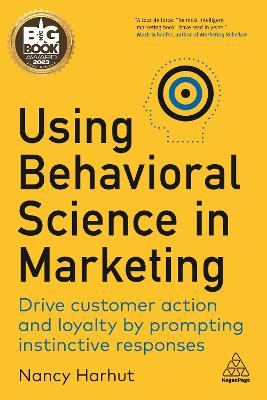Using Behavioral Science in Marketing
 portes grátis
portes grátis
Using Behavioral Science in Marketing
Drive Customer Action and Loyalty by Prompting Instinctive Responses
Harhut, Nancy
Kogan Page Ltd
08/2022
288
Mole
Inglês
9781398606487
15 a 20 dias
440
Descrição não disponível.
Chapter - 01: Emotional and rational elements in decision making;
Chapter - 02: Conveying customer benefits through loss aversion and the endowment effect;
Chapter - 03: Achieving urgency and exclusivity through the scarcity principle;
Chapter - 04: The reciprocity principle and the marketing value of give to get;
Chapter - 05: Social proof - Harnessing the power of people like us, and the people we like;
Chapter - 06: Storytelling - Increasing consumer involvement and engagement;
Chapter - 07: Autonomy bias - Harnessing the human need for control;
Chapter - 08: Encouraging sales and loyalty through the consistency principle and the Zeigarnik effect;
Chapter - 09: Information gap theory - Prompting consumers to take action through curiosity and the need to know;
Chapter - 10: Tapping into the authority principle to stand out and prompt responses;
Chapter - 11: Choice architecture and status quo bias - How to use inertia to get things moving;
Chapter - 12: Labeling and framing - Making people see things your way;
Chapter - 13: Increasing action through automatic compliance triggers and reasons;
Chapter - 14: Maximizing the impact of your marketing copy and language;
Chapter - 15: Increasing desirability though triggering availability bias;
Chapter - 16: Creating stand out marketing communications through context, rewards and unpredictability;
Chapter - 17: Temporal discounting and temporal landmarks - The effects of time on behavior
Chapter - 02: Conveying customer benefits through loss aversion and the endowment effect;
Chapter - 03: Achieving urgency and exclusivity through the scarcity principle;
Chapter - 04: The reciprocity principle and the marketing value of give to get;
Chapter - 05: Social proof - Harnessing the power of people like us, and the people we like;
Chapter - 06: Storytelling - Increasing consumer involvement and engagement;
Chapter - 07: Autonomy bias - Harnessing the human need for control;
Chapter - 08: Encouraging sales and loyalty through the consistency principle and the Zeigarnik effect;
Chapter - 09: Information gap theory - Prompting consumers to take action through curiosity and the need to know;
Chapter - 10: Tapping into the authority principle to stand out and prompt responses;
Chapter - 11: Choice architecture and status quo bias - How to use inertia to get things moving;
Chapter - 12: Labeling and framing - Making people see things your way;
Chapter - 13: Increasing action through automatic compliance triggers and reasons;
Chapter - 14: Maximizing the impact of your marketing copy and language;
Chapter - 15: Increasing desirability though triggering availability bias;
Chapter - 16: Creating stand out marketing communications through context, rewards and unpredictability;
Chapter - 17: Temporal discounting and temporal landmarks - The effects of time on behavior
Este título pertence ao(s) assunto(s) indicados(s). Para ver outros títulos clique no assunto desejado.
Behavioral economics; Consumer psychology; Consumer insights; Buyer behavior; Decision-making; Response rates; Customer engagement
Chapter - 01: Emotional and rational elements in decision making;
Chapter - 02: Conveying customer benefits through loss aversion and the endowment effect;
Chapter - 03: Achieving urgency and exclusivity through the scarcity principle;
Chapter - 04: The reciprocity principle and the marketing value of give to get;
Chapter - 05: Social proof - Harnessing the power of people like us, and the people we like;
Chapter - 06: Storytelling - Increasing consumer involvement and engagement;
Chapter - 07: Autonomy bias - Harnessing the human need for control;
Chapter - 08: Encouraging sales and loyalty through the consistency principle and the Zeigarnik effect;
Chapter - 09: Information gap theory - Prompting consumers to take action through curiosity and the need to know;
Chapter - 10: Tapping into the authority principle to stand out and prompt responses;
Chapter - 11: Choice architecture and status quo bias - How to use inertia to get things moving;
Chapter - 12: Labeling and framing - Making people see things your way;
Chapter - 13: Increasing action through automatic compliance triggers and reasons;
Chapter - 14: Maximizing the impact of your marketing copy and language;
Chapter - 15: Increasing desirability though triggering availability bias;
Chapter - 16: Creating stand out marketing communications through context, rewards and unpredictability;
Chapter - 17: Temporal discounting and temporal landmarks - The effects of time on behavior
Chapter - 02: Conveying customer benefits through loss aversion and the endowment effect;
Chapter - 03: Achieving urgency and exclusivity through the scarcity principle;
Chapter - 04: The reciprocity principle and the marketing value of give to get;
Chapter - 05: Social proof - Harnessing the power of people like us, and the people we like;
Chapter - 06: Storytelling - Increasing consumer involvement and engagement;
Chapter - 07: Autonomy bias - Harnessing the human need for control;
Chapter - 08: Encouraging sales and loyalty through the consistency principle and the Zeigarnik effect;
Chapter - 09: Information gap theory - Prompting consumers to take action through curiosity and the need to know;
Chapter - 10: Tapping into the authority principle to stand out and prompt responses;
Chapter - 11: Choice architecture and status quo bias - How to use inertia to get things moving;
Chapter - 12: Labeling and framing - Making people see things your way;
Chapter - 13: Increasing action through automatic compliance triggers and reasons;
Chapter - 14: Maximizing the impact of your marketing copy and language;
Chapter - 15: Increasing desirability though triggering availability bias;
Chapter - 16: Creating stand out marketing communications through context, rewards and unpredictability;
Chapter - 17: Temporal discounting and temporal landmarks - The effects of time on behavior
Este título pertence ao(s) assunto(s) indicados(s). Para ver outros títulos clique no assunto desejado.







